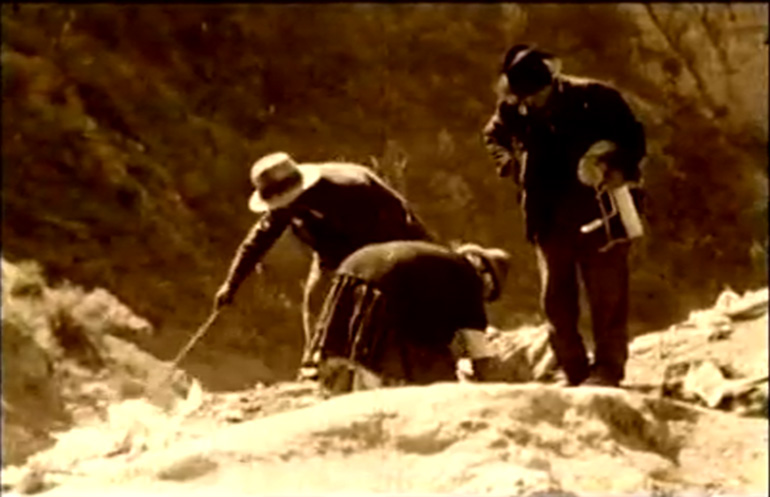REVOLUTION
Jorge Sanjinés
 FORWARD
FORWARD
 DOWNLOAD
DOWNLOAD

TREATMENT
INTRODUCTION
1] The man lives in bad conditions. He lives in holes, among trash and wastes, in caves, in slums, in tenements, in the streets.
2] The garbage dump is the best substitute for everything that the beggar doesn’t have or has lost. He finds in it the few objects he uses, he feeds from it, he dresses from it. He devotes his life to it. And he is there when death comes to him.
3] The man works like a beast. He carries wardrobes, pianos, huge and heavy loads. The man is thin and old. He is blind and he works, he works.
4]The man is lame, blind, poor. He doesn’t have anything other than his sickness and his old age. He begs for money, he asks for help. People pass by him without hearing him, without seeing him. Nobody notices his existence. Slowly he consumes, he gets smaller, thinner.
5] And at dawn, kids who may be men tomorrow are sleeping in a hole. Their blankets are papers. They are cold.
SECOND SEQUENCE
1] There is a man who is working happily. He has a lot of work. He must work fast: he builds coffins for children. His workshop is full of coffins for children. Coffins that are awaiting their turn, that have already a name and an age.
2] There are mothers with the deaths of all their children printed in their eyes.
THIRD SEQUENCE
1] But people are gathering and listening to the leader’s voice. People are shouting and clapping. They are enraged and aroused. They are claiming work, bread, a better life. The leader protests and denounces; he accuses and stirs the masses.
2] Soon the repression, the cane and the violence arise. Soon everything is chaos and darkness, tears, blood, agony...
FORTH SEQUENCE
1] The silence of the cell. The impassible firmness of the bars pointlessly shaken by defeated hands. And, suddenly, the announcement of death of those who rebelled against famine bursts.
2] The announcement of death rises horribly, unbearably, and goes to the tragic looks of those soon to die...
FIFTH SEQUENCE
1] Drum roll, steady. Death roll. The people’s feet aligned. Rifles aim. Each face is living the light in silence, intensely. Each man is alone facing his own death.
2] The people’s feet aligned. The last glance at life. Arms fire and life flees, it collapses. Eyes fixed, glassy; opened, dark mouths. Everything is finished.
SIXTH SEQUENCE
1] Bells. A carrier has a big coffin on his shoulders. Widows, mothers, black clothes, tears: the vigil of someone who has left and lays unmoving.
2] The funeral is a parade. It is still tears, but is already a threat.
3] An old man crosses himself and prays for a soul. For the soul of the dead masses. That have died with José, with Dionisio, with Valerio, with Pedro, with Sandalio...
SEVENTH SEQUENCE
1] The siren rings at the factory. The stop signal is given. And again people tell to themselves: ‘We have to conquer life by giving it! We have to die in order to live!’
2] And these ancient, tragic masses throw stones, wield sticks, pieces of iron, and knock soldiers and henchmen down. They conquer arms, emerge from walls, crosses alleys, their machine guns ready. They shelter, run, take positions. They are determined. Nothing matters anymore. There is a strange vital faith in the eyes of the ones who are about to die or live, in their pulse that doesn’t tremble or yield.
3] People are now awaiting and observing. They are quiet, mortally...
4] Soldiers are coming from afar. They are moving forward, unstoppable. Their eyes are made with the same lead as their bullets. They are moving forward.
EIGHTH SEQUENCE
1] A frightened, dirty boy is looking at us. Another boy is looking at us. Another one comes, with his broken hat and sad eyes. And yet another one with messy hair and torn shirt...
2] Suddenly a fight bursts. The shots break the silence. A child, ragged and small, is frightened. A burst of gunfire makes him shiver.
3] Masses fight, fight for sadness, for that torn shirt, for those glassy eyes. Bullets are being fired and children are hungry, they know nothing. Children are sad, thin. Damn it, something must be done!
FADE TO BLACK
Included in Sanjinés, Jorge and Grupo Ukamau (1979). Teoría y práctica de un cine junto al pueblo. México: Siglo XXI de España Editores.
No 9 EZTETYKA
Editorial. Eztetyka
Albert Elduque
DOCUMENTS
Revolution
Jorge Sanjinés
Tricontinental
Glauber Rocha
Godard by Solanas. Solanas by Godard
Jean-Luc Godard and Fernando Solanas
FILMS UNDER DISCUSSION. INTERVIEWS
A combative cinema with the people. Interview with Bolivian filmmaker Jorge Sanjinés
Cristina Alvares Beskow
Conversation with Eryk Rocha: The legacy of the eternal
Carolina Sourdis (in collaboration with Andrés Pedraza)
The necessary amateur. Cinema, education and politics. Interview with Cezar Migliorin
Albert Elduque
ARTICLES
Reading Latin American Third Cinema manifestos today
Moira Fradinger
From imperfect to popular cinema
Maria Alzuguir Gutierrez
The return of the newsreel (2011-2016) in contemporary cinematic representations of the political event
Raquel Schefer
ImagiNation
José Carlos Avellar
REVIEW
TEN BRINK, Joram and OPPENHEIMER, Joshua (eds.) Killer Images. Documentary Film, Memory and the Performance of Violence
Bruno Hachero Hernández
MONTIEL, Alejandro; MORAL, Javier and CANET, Fernando (coord.) Javier Maqua: más que un cineasta. Volumes 1 and 2
Alan Salvadó Romero

